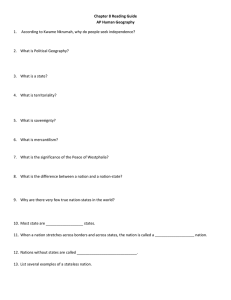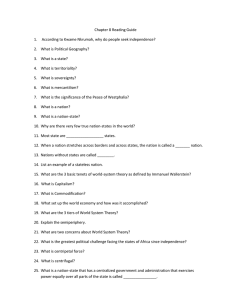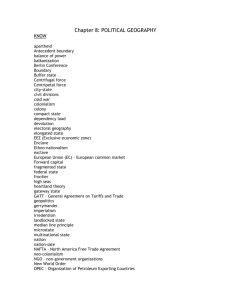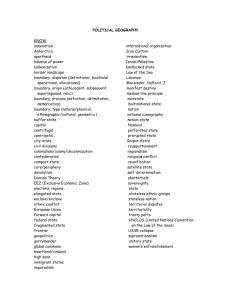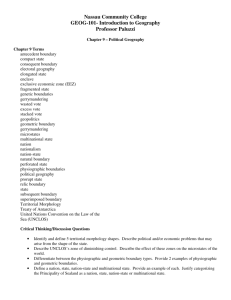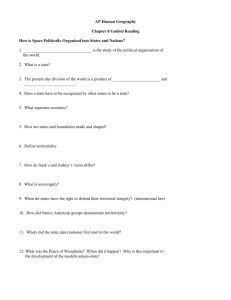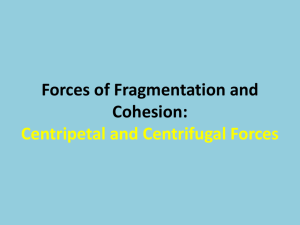The Nation-State - Doral Academy Preparatory
advertisement
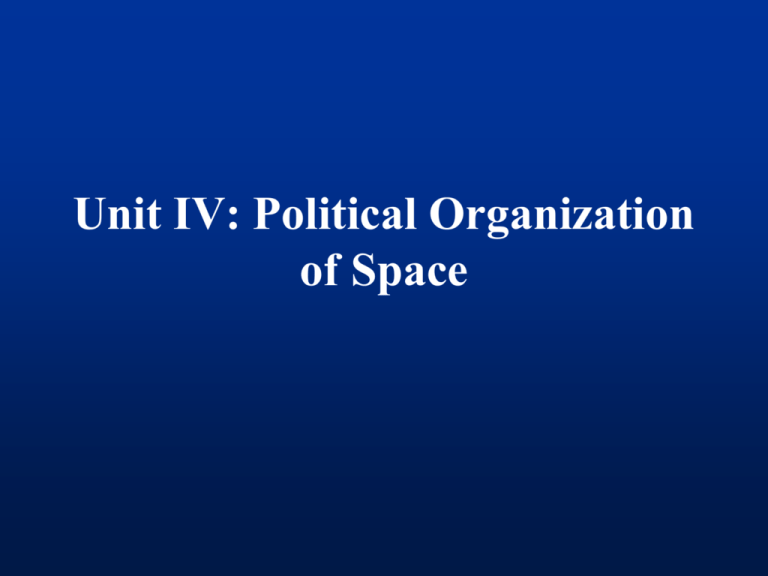
Unit IV: Political Organization of Space Political Geography • organization & distribution of political phenomena Territory • effort to control land • world divided by borders – countries (or “states”) I. States 1. independent political unit 2. w/ defined territory 3. must be recognized by others World States • 192 recognized by UN Issues defining states • some territories not recognized: – Taiwan – Tibet – Western Sahara • A cultural unit bound by sense of shared beliefs/customs II. Nations “Stateless Nations” • Nations without a country – Palestinians – Kurds – Basques Multinational State •A state with more than one nation. The Former Yugoslavia The Nation-State • a nation & a state (country w/ homogenous culture) • about 20 countries Exs: Iceland, Portugal, Poland, Japan Types of Relationship s Between “states” & “nations” a. nation-state b. multi-national state (Cyprus) c. part-nation state (Arab) d. stateless nation Spatial Characteristics of States • Smallest: City-states: • Singapore, Monaco, San Marino Microstates: Andorra, The Vatican • Largest: Russia 5 basic shapes: – Compact (Uruguay, Zimbabwe, Poland) – Prorupt (extension out; Thailand) – Elongated (Chile) – Fragmented (difficult to defend; Philippines, Indonesia) – Perforated (country that surrounds another; South Africa B E A D C Relative Location • size and shape matter! • absolute & relative location matter! Ex: Singapore, Switzerland • Landlocked countries usually at disadvantage – Bolivia Boundary Types 1. Physical: mountains, rivers, lakes 2. Geometric: lines of latitude/longitude 3. Cultural: separated by language/religion – India & Pakistan Boundary Origins 1. Antecedent: border before populated Ex: U.S. 2. Subsequent: border drawn after 2 types: • Consequent (Ireland & N. Ireland) • Superimposed (British India) Consequent – Ireland & N. Ireland 3. Relict/relic Boundary: historical boundary U.N. Convention of the Law of the Sea • Territorial waters: 12 NM out • Exclusive Economic Zone: 200 NM (fish, mineral resources) Types of Boundary Disputes 1. Positional: over border 2. Functional: over policies (immigration) 3. Resource (oil) 4. Territorial - irredentism Capital Cities: • usually centralized (“core” area) Primate City: dominates economic activity • some capitals relocated: – Forward Thrust Capital (Abuja, Brazilia, Canberra, Islamabad) Nigeria - Abuja Geopolitics Ratzel’s Organic Theory: countries are living organisms Mackinder Heartland Theory: land-based power (pivot area Europe) Spykman Rimland Theory: naval power Forms of Government Unitary: centralized gov’t (strong capital) Federal: gov’t organized by territories Centripetal Forces • • • • promote cohesion nationalism unify better transportation/communication Centrifugal Forces • challenges to the state • ethno-nationalism • devolution (autonomous regional gov’t); regionalism • inequality Ethnocultural Devolutionary Movements Eastern Europe devolutionary forces since the fall of communism Economic Devolutionary Movements Catalonia, Spain Barcelona is the center of banking and commerce in Spain and the region is much wealthier than the rest of Spain. Electoral Geography Gerrymandering: redrawing of voting districts to benefit 1 political party • protects minority districts Supranational Organizations: 3 or more states form an alliance - military (NATO) - economic (EU, NAFTA) -political (UN) Global Scale – The United Nations Regional Scale – The European Union
